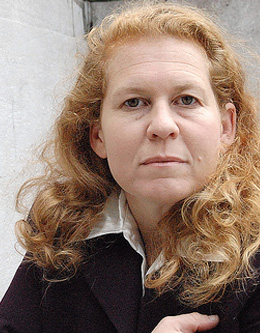Purple Haze
A doctor would diagnose these young people with autism, ADHD, or another developmental disorder. But to legions of believers, Indigo Children are the next step
in human evolution.
What do Unabomber Ted Kaczynski, Leonardo DaVinci, and Jenny McCarthy all have in common?
“The day I found out I was an adult Indigo,” McCarthy wrote in a 2006 blog entry, “will stay with me forever. I was walking hand in hand with my son down a Los Angeles street when this [woman] approached me and said, ‘You’re an Indigo and your son is a Crystal.’ I immediately replied, ‘Yes!’ and the woman smiled at me and walked away.” Shortly after, McCarthy started IndigoMoms.com, an online forum for mothers to discuss their “special little spirits’ soul mission” that she promoted with apparel and an appearance on Jay Leno’s Tonight Show.
Generations of twentysomethings best remember McCarthy as a former Playboy playmate and spunky co-host of MTV’s dating show Singled Out. When her son was diagnosed with autism before his third birthday, McCarthy went on a media crusade to raise awareness about the spectrum disorder. Parents of children with autism and other neurodevelopmental disorders heralded her as a leader of the neurodiversity movement, optimistic her celebrity could help their cause. So it came as a slap in the face to them when McCarthy awakened to a phenomenon far removed from mainstream medicine.
In The Indigo Children: The New Kids Have Arrived, motivational speakers and metaphysicians Lee Carroll and Jan Tober compiled a mish-mash of interviews and anecdotes related to them by education specialists, New Age gurus, and children and their families detailing “the most exciting…change in basic human nature that has ever been observed”: a worldwide concept of highly sensitive children with a keen intuition, artistic spirit, defiant sense of purpose, and the occasional psychic ability. Some Indigos report channeling spirits and angels, while others claim they are themselves angels who can remember past lives, though possessing a supposed psychic ability is not a requirement to be Indigo. A child is usually Indigo into early adolescence, but the label can apply into adulthood depending on how strongly the personality remains characteristically Indigo. More recently, The Complete Idiot’s Guide To Indigo Children asserts, “Indigo children defy categorization,” before listing a page of celebrities the authors (two other New Age spiritualists) speculate are or were Indigo according to their rubric. Besides the aforementioned, Steve Jobs, George Lucas and Amelia Earhart have all been anointed Indigo. (The Indigo Girls are conspicuously absent.) As the next step in human evolution and supposed catalysts for high levels of spiritual change in the world, Indigos comprise an estimated 95 percent of the children born since 1999, according to the authors. Crystal children are the most recent category emerging on the horizon. Their role is to temper the impact caused by Indigos.
Originating from her observations that some children emanated a purple glow, or aura, about them, Nancy Ann Tappe, a parapsychologist and self-identifying synesthete and psychic, first introduced the term Indigo in the 1980s. Auras are mystical electromagnetic energies also referred to as “life colors” or “chakras.” According to believers, the aura’s color reveals the true nature of a person. The Indigo aura, one of the most highly regarded, is indicative of deep feeling, creativity, sensitivity, and intuition.
But to the average observer untrained in New Age ideology, these hues are nonexistent. Physicians and psychologists examining Indigo children frequently observe behavioral and emotional problems that prompt diagnoses of ADHD, bipolar disorder, Asperger’s and autism, and sometimes worse. Literature on Indigos provides an all-encompassing array of special abilities, quirks, and behaviors these children possess: extreme defiance of authority, nonconformity in generalized social settings, daydreaming, and high creativity are just a few identifying traits of children with Indigo auras—and spectrum disorders, and ADHD. Because many of these characteristics overlap with symptoms of neurodevelopmental disorders, skeptics of the Indigo movement argue that parents subscribing to the idea are in denial of their children’s medical conditions and withholding necessary therapies. Others simply chalk it up to lazy parenting: on the online vending site CaféPress.com, one merchant sells a t-shirt that reads, “I’m not BAD. I’m Indigo.”
In spite of this backlash, at least 14 books have been published on how to raise your Indigo child in the last ten years alone, including one this past February. While mainstream media coverage has dwindled (a resurgence egged on by IndigoMoms.com in 2006 caught the attention of ABC News, CNN, and the New York Times), the movement’s momentum is not slowing. Tober and Carroll’s landmark, now in its 38th printing, was translated into Spanish. Seminars by Tober, Carroll, and followers are still selling (and frequently selling out) internationally, some for hundreds of dollars. Dozens of websites and message boards thrive with activity from dedicated parents who believe seeing their children through Indigo-colored glasses has helped in raising them in happiness and good health. And curious mothers and fathers to this day wonder if they should be doing same.

